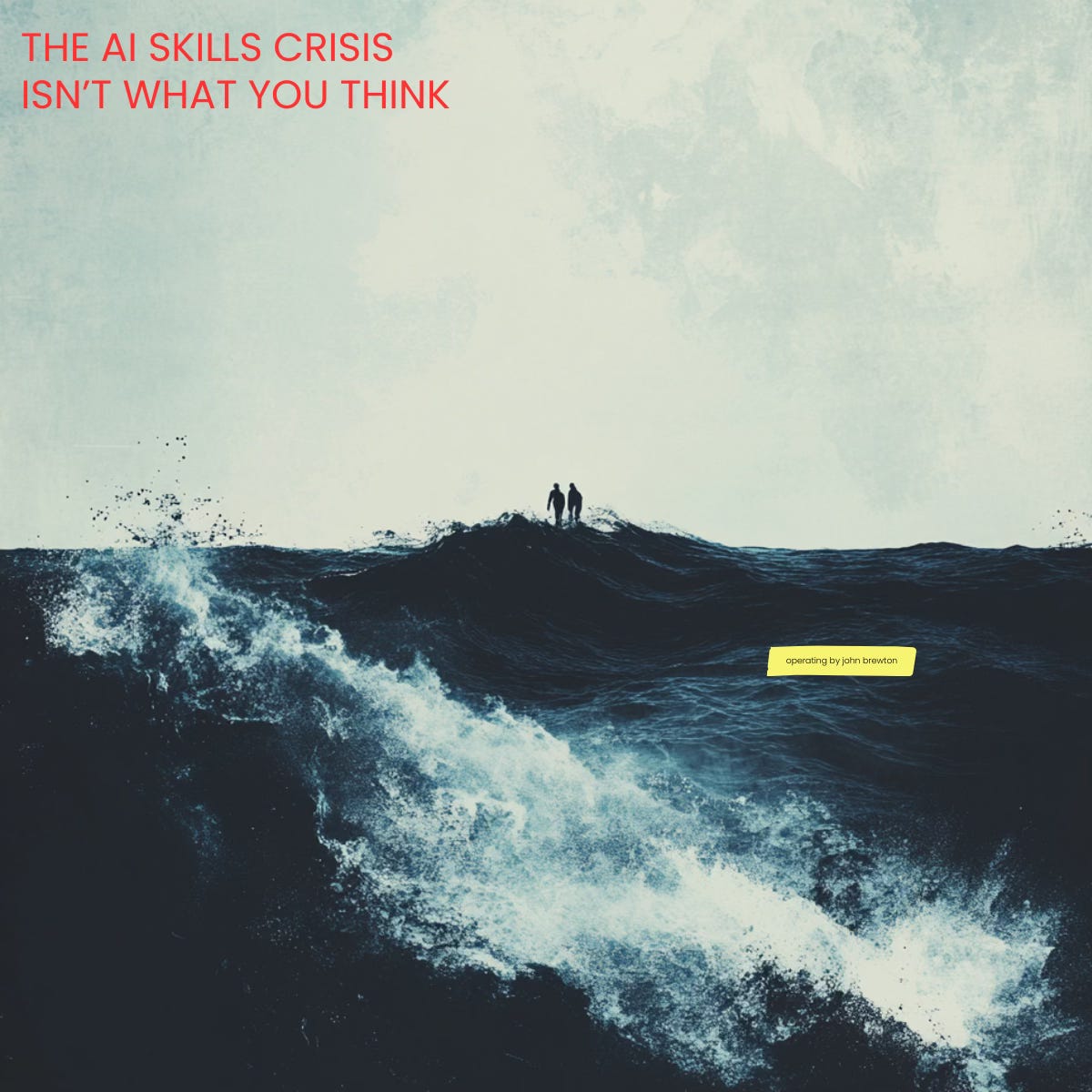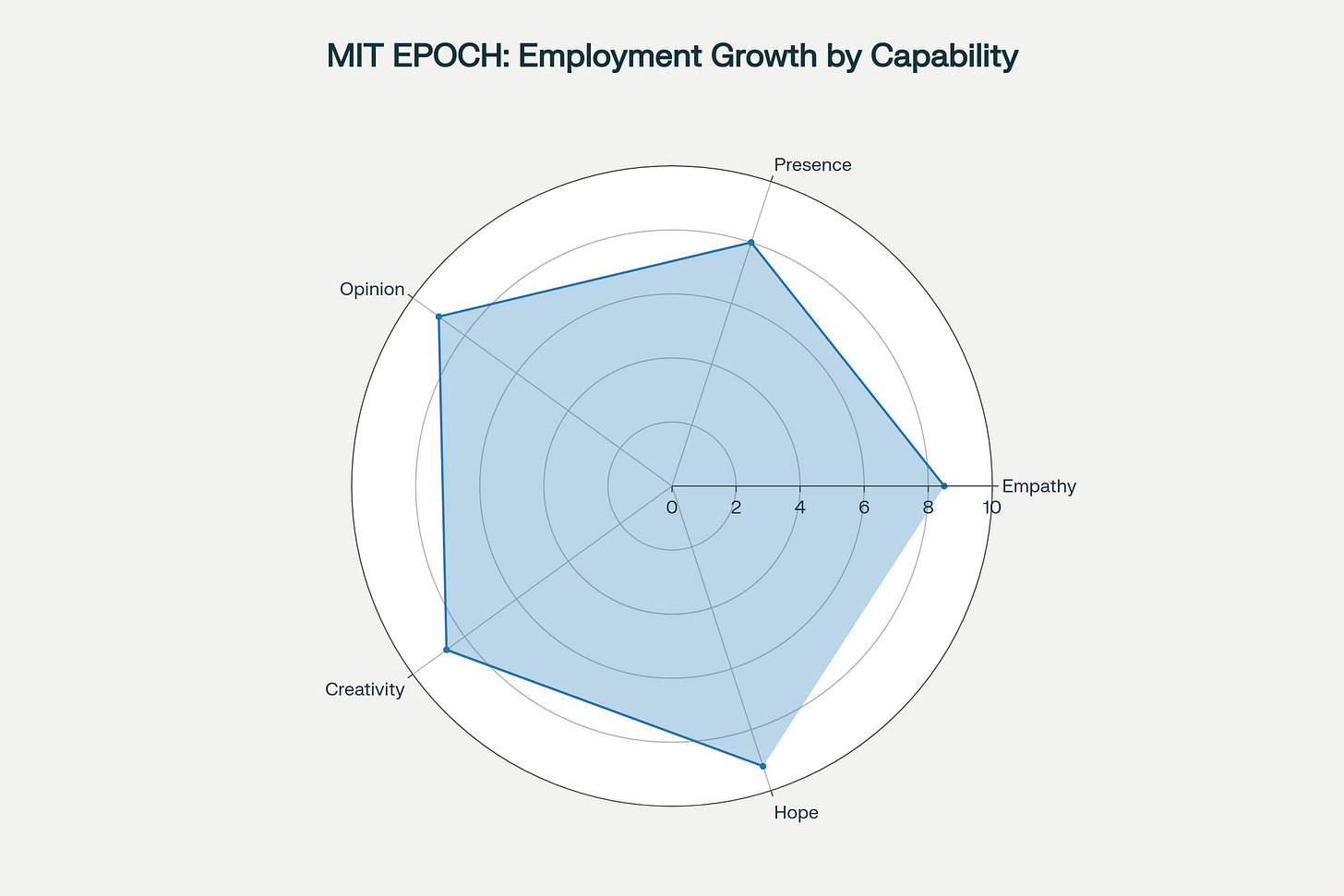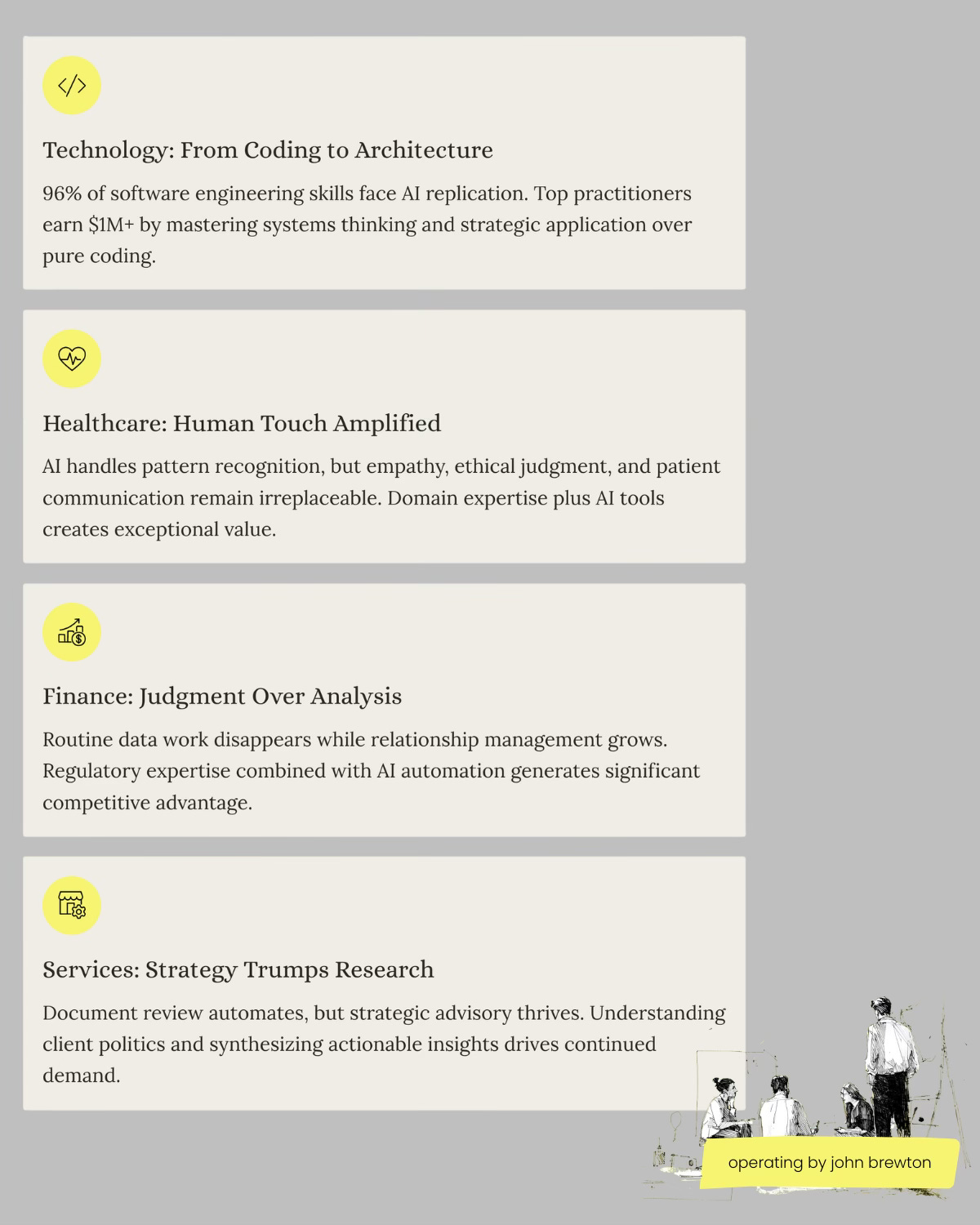The AI Skills Crisis Isn’t What You Think
Why 87% of Companies Fail at AI and How the Other 13% Win
Check out these reader favorites:
78 Million Unfilled Jobs
While headlines scream about AI destroying jobs, our labor market is building towards an antithetical crisis: 78 million new roles with no one qualified to fill them.
Through October, over 1.1 million job cuts have been announced across the United States, yet only 31,000 were explicitly attributed to artificial intelligence. The real unemployment isn’t coming from machines, it’s from obsolete capabilities.
The paradox is stark. The World Economic Forum projects that AI will displace 92 million jobs globally by 2030 while simultaneously creating 170 million new positions, a net gain of 78 million jobs. Yet most workers will fail to bridge this gap, because the jobs being created demand fundamentally different capabilities than those disappearing.
More telling is what’s happening inside organizations claiming to embrace AI. While 97% of C-suite executives view artificial intelligence as transformational, only 13% of companies report creating measurable business value from their investments, an 84-percentage-point gap between perception and execution. This isn’t a technology problem. It’s a skills infrastructure crisis.
The Real Crisis
Skills Infrastructure, Not AI Adoption
The constraint is human capital. Organizations purchase AI tools, deploy platforms, and mandate adoption, yet fail to build workforce capabilities necessary to leverage these systems effectively. The result is expensive technology that generates a minimal return.
Research from Wharton, MIT, and Kellogg reveals the pattern: 74% of companies using generative AI see measurable returns when they pair technology deployment with comprehensive training. The 13% achieving significant value share common characteristics; systematic skills assessment, investment in workforce development accompanying technology purchases, cultural change enabling experimentation, and measurement frameworks linking AI adoption to business outcomes.
The organizations that successfully deploy AI achieve profitability gains exceeding 40% and free up over 50% of labor capacity for higher-value work. But these outcomes require what researchers term “AI methodology,” not simply installing tools but redesigning workflows, restructuring roles, redefining success metrics, and investing in capability development at every organizational level.
The inverse is equally revealing. Organizations that purchase AI technology without redesigning workflows or investing in training see minimal productivity gains despite substantial expenditures. Those who invest in technology and training but leave organizational structures unchanged encounter adoption barriers, as new capabilities clash with outdated incentive systems.
The Entry-Level Apocalypse
Stanford research documents a 13% decline in employment among workers aged 22-25 in AI-exposed occupations since late 2022, while employment for other age cohorts remained stable or grew. Entry-level job postings have declined by 35% since January 2023, with significant contractions in technology, finance, and professional services.
The concern extends beyond immediate unemployment to structural damage to career development pathways. Entry-level positions in consulting, law, accounting, and software engineering traditionally served dual purposes, they delivered value to employers while providing on-the-job training for junior staff. Associates conducted research, drafted documents, built models, and managed routine client interactions.
As AI handles these tasks, the traditional apprenticeship model breaks down.
A senior partner at a major consulting firm can now use AI to produce analysis that previously required three junior consultants, but those consultants no longer develop the skills to become senior partners themselves.
If junior roles vanish, where do mid-career professionals come from?
How do organizations develop the expertise that senior positions require?
The long-term implications trouble organizational strategists. Bootcamps, online courses, and self-directed learning are proposed as alternatives to workplace apprenticeship, but these substitutes lack the contextual richness, mentorship, and progressive complexity that traditional career ladders provided.
The Skills Hierarchy Has Inverted
What’s most counterintuitive about this transformation is which capabilities matter. Technical competencies that commanded premium wages for decades are being commoditized as AI replicates capabilities once requiring years to master. Meanwhile, human capabilities, emotional intelligence, judgment, creativity, leadership, now create decisive value.
MIT researchers Isabella Loaiza and Roberto Rigobon developed what has become the definitive framework for understanding which human capabilities AI cannot replicate. Their EPOCH typology emerged from empirical analysis of employment trends from 2016 to 2024:
Empathy
Presence (networking/connectedness)
Opinion (judgment/ethics)
Creativity
Hope (vision/leadership)
Jobs scoring high on EPOCH dimensions experienced employment growth even as AI adoption accelerated. Emergency management directors, clinical psychologists, public relations specialists, and creative directors all showed expanding demand. Conversely, roles defined by codifiable procedures and pattern recognition, such as data entry, routine analysis, and basic customer service, faced steep declines.
Critically, the researchers deliberately avoid labeling these as “soft skills,” noting that “hard skills” like solving math problems are comparatively easy to teach. It is much harder to teach hope, empathy, and creativity.
The terminology inversion reflects an economic reality: capabilities once considered peripheral are now central to value creation, while technical skills are increasingly commoditized.
The Three Pillars Framework
Top business schools (Harvard, MIT, Wharton, Kellogg, Stanford, and Berkeley) have converged on a consistent framework despite approaching the question from different research traditions. Analysis of their newly launched AI programs reveals three essential skill domains that distinguish those who thrive from those who are left behind.
Pillar One: AI Fluency and Technical Competencies
Baseline AI literacy: understanding what AI is, how it functions, its capabilities and limitations, and when to deploy it is now foundational for professional competence. But this isn’t about learning to code. It’s about developing what Kellogg researchers call “domain-specific AI integration”: understanding how AI applies to your particular function, industry constraints, and success metrics.
The distinguishing insight: AI fluency is universal, but differentiation comes from depth of application. A marketing professional needs different AI capabilities than a healthcare administrator or manufacturing operations manager. The value is derived from being able to distinguish which business problems AI can solve and which it cannot.
Pillar Two: EPOCH Capabilities
The Human Advantage
The EPOCH framework reveals where humans retain a decisive advantage.
Empathy and Emotional Intelligence encompass roles requiring attunement to others’ emotions and managing relationships with nuance. Jobs demanding genuine human connection (clinical psychology, human resources, complex customer relationships) experienced employment growth even as routine service roles automated.
Presence, Networking, and Connectedness capture capabilities are dependent on human relationships and trust-building over time. Roles where who you know matters as much as what you know (sales, business development, executive management) rely on presence that AI cannot replicate.
Opinion, Judgment, and Ethics represents principled decision-making that extends beyond algorithmic optimization. When trade-offs involve values rather than metrics, when ethical considerations constrain technical solutions, or when judgment must account for intangibles, human opinion remains essential.
Creativity and Imagination distinguish conceptual innovation from pattern replication. While AI excels at combining existing elements in novel ways, genuine creativity, reconceptualizing problems, imagining futures unconstrained by precedent, remains distinctly human.
Hope, Vision, and Leadership represent the most uniquely human dimensions—maintaining a long-term orientation, inspiring others toward a shared purpose, and demonstrating resilience in the face of setbacks. MIT researchers found that this capability showed the most significant positive correlation with employment growth.
Pillar Three: Strategic and Business Acumen
Harvard Business School research emphasizes that successful AI deployment requires clear strategic frameworks. Organizations must answer fundamental questions: Where should AI augment versus automate? What competitive advantages emerge when everyone has similar tools? How should workflows be redesigned around AI capabilities?
As AI handles routine analysis, financial literacy and business acumen become increasingly critical, not less so. Wharton research demonstrates that while 74% of companies using generative AI see measurable ROI, leaders must be capable of quantifying and communicating value—understanding how to measure AI’s impact on productivity, quality, cost, and revenue.
Systems thinking emerges as critical across institutions. When AI transforms one role, adjacent positions must adapt. When data flows change, downstream analytics and decision-making are affected. Strategic leaders see these interconnections and design holistic transformations rather than piecemeal interventions.
We’re releasing a free companion resource tonight that operationalizes this framework, including self-assessment tools, development roadmaps, and curated resources.
Industry-Specific Patterns
While the Three Pillars framework applies broadly, skill priorities vary substantially across industries.
The Velocity Challenge
What distinguishes this transition from previous technological revolutions is compression. The Economist notes that what previous transformations accomplished over 30-50 years, AI may compress into 10-15 years. The accelerated timeline reduces the window for adaptation and increases the risk that displaced workers will be unable to retrain quickly enough.
The skills' half-life, the time it takes for half of what you know to become outdated, has compressed from decades to years in many professions. For software engineers, the half-life of specific technical knowledge approaches 18-24 months. Analysis by The New York Times and LinkedIn reveals that 25% of the skills required for professional positions changed between 2015 and 2025, a span of ten years. Projections suggest 65% of current skills will be transformed or rendered obsolete by 2030, a comparable change compressed into just five years.
Traditional training program development timelines, ranging from three to six months, cannot keep pace with the evolution of AI. By the time formal curricula are written, approved, and deployed, tools have advanced and content has partially been obsoleted.
The Path Forward
Harvard Business School Professor Karim Lakhani’s observation captures the essential dynamic: “AI won’t replace humans, but humans with AI will replace humans without AI.” The question isn’t whether AI will transform work, that transformation is already underway, but whether individuals and organizations will adapt at a sufficient speed and comprehensiveness to capture opportunities rather than suffer disruption.
The evidence points to a clear imperative. Organizations that recognize training investment as strategic rather than tactical can differentiate themselves rapidly. In markets where 87% of competitors fail to extract value from AI despite purchasing similar tools, those that build workforce capability create a sustainable competitive advantage.
The economic logic is straightforward. AI tools represent a capital investment with depreciating value as their capabilities become commoditized. Workforce capabilities represent compounding investment that becomes more valuable over time as employees develop judgment for when to use AI, how to direct it effectively, and where human override is necessary. The former is an expense; the latter is an asset.
For individuals, the stakes are equally high. Research documents a massive gap between worker aspiration and institutional provision. Among surveyed workers, 96% recognize AI skills as essential for their careers, and 83% view AI proficiency as crucial to their future employability. Yet only 45% have pursued any AI training. The gap is not motivational but structural, when employers provide training with clear support, 70% of workers complete programs.
The net job gain projection of 78 million new positions by 2030 offers reason for optimism but requires action. Those jobs materialize only if workers develop required capabilities, organizations invest in transformation rather than simple automation, and the choices made over the next several years prioritize augmentation over elimination.
The AI skills crisis isn’t coming; it’s here. But unlike previous workforce transformations, this one rewards preparation over pedigree. The question isn’t whether your organization will adapt, but whether you’ll be in the 13% that does it effectively.
Paid subscribers receive our deeper research analysis later this week, featuring full organizational case studies, industry-specific implementation playbooks, and complete academic methodology.
Operating by John Brewton goes deep on what it takes to build, scale, and optimize modern companies. This breakdown analysis is just the starting point. Check out last week’s analysis of Amazon’s current operating strategy to see more.
John Brewton documents the history and future of operating companies at Operating by John Brewton. He is a graduate of Harvard University and began his career as a Phd. student in economics at the University of Chicago. After selling his family’s B2B industrial distribution company in 2021, he has been helping business owners, founders and investors optimize their operations ever since. He is the founder of 6A East Partners, a research and advisory firm asking the question: What is the future of companies? He still cringes at his early LinkedIn posts and loves making content each and everyday, despite the protestations of his beloved wife, Fabiola, at times.
Sources
World Economic Forum
Stanford
AI and Labor Markets: What We Know and Don’t Know | Stanford Digital Economy Lab
Canaries in the Coal Mine? Six Facts about the Recent ... | Stanford Digital Economy Lab
MIT — EPOCH Framework
These human capabilities complement AI’s shortcomings | MIT Sloan
New MIT Sloan research suggests that AI is more likely to complement, not replace human workers
Wharton — AI Workforce & Enterprise Value
2025 AI Adoption Report: Gen AI Fast-Tracks Into the Enterprise | Wharton
Gen AI Fast-Tracks Into the Enterprise (PDF) | Wharton Human-AI Research
What Wharton’s Latest Research Reveals About Enterprise Adoption | CHRO.org
Kellogg — Domain-Specific Integration
Harvard Business School — Karim Lakhani, AI Strategy
LinkedIn — AI Skills, Salary, Workforce Dynamics
Why workers must upskill as AI accelerates workplace changes | World Economic Forum & LinkedIn
Reskilling in the AI Era: A Roadmap for Upskilling Your Workforce | LinkedIn
New York Times — Half-Life of Skills, Job Cuts
Thank you for reading. I so sincerely appreciate your taking the time.
- j -










Excellent article John. The ability to embrace AI and develop the skills necessary to advance your career or business will determine who wins.
Looking forward to diving into this one